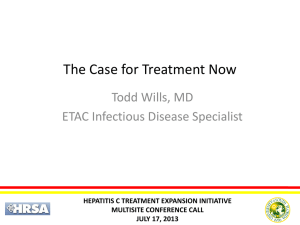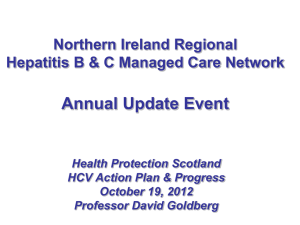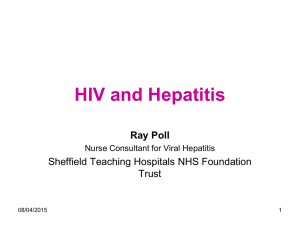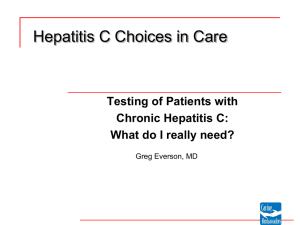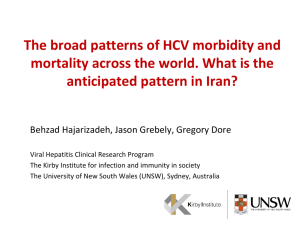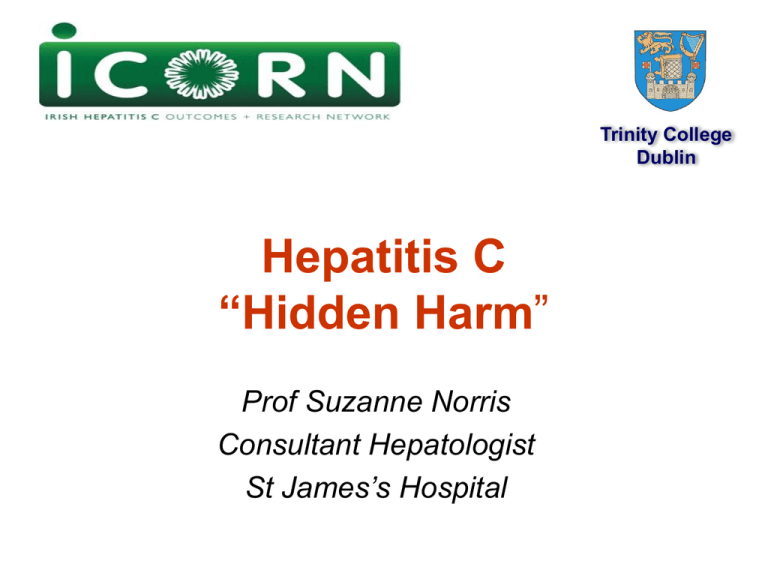
Trinity College
Dublin
Hepatitis C
“Hidden Harm”
Prof Suzanne Norris
Consultant Hepatologist
St James’s Hospital
Global burden of Hepatitis C virus
infection: Europe
Cornberg M et al Liver International 2011; 31 (Suppl 2):30-60
Global Burden of HCV:
Barriers to Testing, Care, Treatment
• Developed countries
– Most HCV-infected persons are unaware of their infection
– Inadequate knowledge and awareness of HCV among healthcare
providers and their patients
– Cost-related factors
– Lack of HCV screening policies
• Developing countries
– Same barriers as in developed countries, plus
• Low political, provider, and community awareness of HCV as a
significant health threat
• Lack of understanding among public health officials on the true
burden of disease
• One-third of the WHO Member Countries do not collect
prevalence data for viral hepatitis
Averhoff FM, et al. Clin Infect Dis. 2012;55(suppl 1):S10-S15.
Hepatitis C in Ireland
1800
40
1600
35
1400
1200
1000
800
600
1547
30
1516
By 2013, 12,365 diagnosed
Prevalence is 20,000-50,000
1405
1121
1241
1213
1239
25
20
15
400
10
200
5
0
0
2004
2005
Male
Mean age males
2006
2007
2008
FemaleYear
Mean age females
2009
2010
Unknown sex
Mean age
Number of notifications
Number of notifications of hepatitis C 2004-2010, by
sex and mean age
Mean annual notification rates per 100,000 for
hepatitis C by age and sex, 2004-2012
Most likely risk factor (%) for cases of hepatitis C
notified 2007-2010 (where data available, n=2772,
50%)
No known risk
factor, 4.2
Vertical, 1.1
Other, 7.4
Injecting drug
user, 75.9
Possible sexual
exposure, 3.4
Received blood
or blood
products, 3.9
Born in endemic
country or
asylum seeker,
4.1
Most likely risk factor (%) for cases of hepatitis C
notified 2007-2010 (where data available, n=2772,
50%)
No known risk
factor, 4.2
1.1
HCVVertical,
genotypes
1 and 3 are the most common
Other, 7.4
Injecting drug
user, 75.9
Possible sexual
exposure, 3.4
Received blood
or blood
products, 3.9
Born in endemic
country or
asylum seeker,
4.1
In Ireland, 62–79% of injection drug
users are positive for anti-HCV
Prevalence of HCV among injection drug users in Ireland
62–79%
Fitzgerald et al. IMJ 2001;170:32
Grogan et al. IMJ 2005;174(2):14
Smyth et al. Addiction 1998;93(11):1649
Smyth et al. J Epid Com Health 2003;57;310
Cullen et al. IMJ 2003;172(3):1213
Epidemiology in Ireland: Prisons
Prison census
survey
Prevalence rate
(n=1205)
HBV
9%
HCV
37% (81% IDU)
HIV
2%
Committal
survey
(n=607)
6%
22% (72% IDU)
2%
17–21% started injecting drugs in prison
Department of Community Health and General Practice, Trinity College, Dublin. Hepatitis B, Hepatitis
C and HIV In Irish Prisoners, Part II: Prevalence and Risk in Committal Prisoners 1999
Epidemiology: Ireland
– No seroprevalence data from general population
– Of 62,667 women screened in the anti-D RhIg
Programme, seroprevalence of HCV Ab positivity was
1.1%
Kenny-Walsh et al, NEJM1999;340:1228
– Optional HCV Screening Programme of transfusion
recipients, 1995 – 2002: 14,917 individuals screened
(85% female) with seroprevalence rate of 0.3%
Davoren et al, Transfusion 2002;42:1501
HCV and the individual
• 10–20% of patients with HCV will develop cirrhosis
after 20–30 years
EASL. J Hepatol 2014;60:392–42
Risk factors that may affect
progression of HCV Infection
Factors contributing added risk to developing cirrhosis or HCC
Steatohepatitis/obesity1
Diabetes2
HIV coinfection1
Presence of varices2
Hepatitis B coinfection1
Low platelet count2
Alcohol intake1
Increasing age2
Smoking1
Black ethnic group2
Healthy Liver
Hepatic Fibrosis
Cirrhosis
Liver Cancer
SF36 score
Effect of chronic HCV infection on QoL
measured using SF36 questionnaire
100
90
80
70
60
50
40
30
20
10
0
Controls
Mild disease
Severe disease
Physical
Social
functioning functioning
Role –
physical
Foster GR et al. Hepatology 1998;27:209–12
Role –
emotional
Mental
health
Energy and
fatigue
Pain
General
health
perception
(SF-36 scale)
Change from baseline in HRQoL
Change in quality of life following
interferon therapy
35
30
25
20
15
10
5
0
–5
**
Responder (n=41)
Non-responder
(n=396)
*
Physical
function
**
Role
physical
Bodily
pain
General
health
*
*
Vitality
Social
function
Role
emotional
Mental
health
* p<0.05
**p<0.01
US multicentre randomised double-blind controlled study of 704 patients
receiving 3µg inteferon, 9µg consensus interferon or 15µg interferon-alfa-2b 3
times a week for 24 weeks. Responder =undetectable HCV RNA at 24 weeks’
post-treatment
Bonkovsky HL et al. Hepatology 1999;29:264–70
Patients (%)
Indirect economic costs of HCV
30
Patients with HCV
Controls
20
10
0
Absenteeism
Presenteeism
Overall work
impairment
Activity
impairment
• Data from the 2009 US National Health and Wellness Survey showed patients with HCV
were significantly less likely to be employed vs controls (p<0.0001). HCV in the EU
population significantly impacts several domains of HRQL (p<0.05)
DiBonaventura M et al. J Med Econ 2011;14:253–61
DiBonaventura M et al. Eur J Gastroenterol Hepatol 2012;24:869–77
REVEAL Study: risk of chronic HCV infection
on hepatic and extrahepatic deaths
• Community based, long-term, prospective study
– Invited 89,293 residents (aged 30-65 years) from 7
townships in Taiwan
• 23,820 (26.7%) agreed to participate
• Current analysis (n=19,636 HBsAg-negative)
– Anti-HCV seronegative (n=18,541)
– Anti-HCV seropositive (n=1095)
• Detectable HCV RNA: 69.4%
• 2394 deaths over 317,742 person-years of follow-up
– Average follow-up: 16.2 years
– Overall mortality: 753.4 per 100,000 person-years
REVEAL: Risk Evaluation of Viral Load Elevation and Associated Liver Disease/Cancer.
Enrollment 1991-1992. Last follow-up: 12/2008.
Lee M-H, et al. J Infect Dis. 2012; 206:469-477.
REVEAL Study Mortality:
Liver Cancer and Cirrhosis
Liver Cancer
Chronic Liver Diseases
and Cirrhosis
(n=115)
(n=76)
Anti-HCV+, HCV RNA detectable
Anti-HCV+, HCV RNA undetectable
Anti-HCV-
Cumulative Mortality (%)
Cumulative Mortality (%)
Anti-HCV+, HCV RNA detectable
Anti-HCV+, HCV RNA undetectable
10.4%*
Anti-HCV-
2.8%†
1.6%
0.3%
0.3%
0 2 4 6 8 10 12 14 16 18 20
Follow-Up (Years)
0 2 4 6 8 10 12 14 16 18 20
Follow-Up (Years)
REVEAL: Risk Evaluation of Viral Load Elevation and Associated Liver Disease/Cancer.
*P<0.001 for comparison among all 3 groups and P<0.001 for HCV RNA detectable versus undetectable.
†P<0.001 for comparison among all 3 groups and P=0.005 for HCV RNA detectable versus undetectable.
Lee M-H, et al. J Infect Dis. 2012; 206:469-477.
0%
UK hospital admissions due to HCVrelated ESLD and HCC are increasing
Annual number of individuals in England, Scotland and Wales hospitalised with HCV-related
ESLD or HCV-related HCC:1998-2010
HPA report 2012 Available at: www.hpa.org.uk/webw/HPAweb&HPAwebStandard/HPAweb_C/1317135237627 Accessed June 2013
UK deaths from HCV-related ESLD and
HCC are increasing
Deaths from HCV-related ESLD or HCV-related HCC mentioned on the death certificate
in the UK:1996-2010
HPA report 2012 Available at: www.hpa.org.uk/webw/HPAweb&HPAwebStandard/HPAweb_C/1317135237627 Accessed June 2013
Burden of HCC in Ireland
HCV-related transplants 2001-2011
We apologise that this information is not able to shared online as it is unpublished data
A viral cure can be achieved in
HCV infection
Achievement of a sustained virologic response (SVR) following
completion of treatment is indicative of successful therapy and is
synonymous with a cure
Acute
Infection
Soriano V, et al. J Antimicrob Chemother. 2008;62:1–4.
Smith BD, et al. MMWR. 2012;61(4):1-32.
Metzner KJ. Future Virol. 2006;1:377-91
Chronic
Infection
Successful
Therapy
Does SVR equal cure of liver disease?
• Viral eradication stops progression of disease
• Mild Disease - long-term outcome = pop’n risk
286 pts with SVR after IFN therapy
SVRs (n=286)
Survival
% survival
Proportion of patients
Follow-up post SVR (n=286)
Matched general
population
Decompensation/HCC
Time [yrs]
Time [yrs]
Veldt Gut 2002
SVR saves lives
Long-term follow-up of patients with cirrhosis post-treatment
Overall Mortality, %
30 10-year occurence
SVR:
8.9% (95%CI 3.3-14.5)
non-SVR: 26.0% (95%CI 20.2-28.4)
20
Non-SVR
p<0.001
10
SVR
0
0
1
2
3
4
5
6
7
8
9
10
Follow-up time, years
SVR eliminates liver failure
Van de Meer et al 2012
Number of events
Benefits of SVR: reduction in
liver-related disease
Mortality Rates and Hospital Episode Rates (Per 100 Person Years) by SVR Status
Observed Among 1,215 Post-Treatment HCV Patients in Scotland, 1996-2007
Innes HA et al. Hepatology 2011;54:1547-1558.
Bottom line
Non-Cirrhotics
•SVR = cure normal life expectancy
Cirrhotics
•SVR eliminates liver failure
•SVR greatly reduces the risk of HCC
•SVR improves liver-related AND overall survival
In a cost curtailed environment is curing a
disease more effective than managing a disease
- diabetes versus HCV?
Case-finding critical
Reduction in cumulative
Incidence of death
Peg/RBV
40
Deuffic-Burban et al Gastro 2012
34
31
30
30
27
25
15
Peg/RBV/PI + Screening
37
34
35
20
Peg/RBV/PI
24
24
20
18
16
13
18
14
10
10
12
8
8
5
0
Belgium
France
Germany
Italy
Spain
UK
Treatment only effective for those who receive it…
Modelled number of IDUs in Scotland with liver failure
with different uptake rates of HCV therapy, 2008-2030
0 former IDUs per year
Assuming uptake of HCV
antiviral therapy by:
225 former IDUs per year
1,000 former IDUs per year
(up to) 2,000 former IDUs per year
Number of patients ever treated with PEG per 100
prevalent HCV cases* by country until end of 2005
16
3
1
Lettmeier et al JHepatol 2008
HCV mono-infection landscape in Ireland
We apologise that this information is not able to shared online as it is unpublished data
HCV mono-infection treatment
programme in St James’s Hospital
We apologise that this information is not able to shared online as it is unpublished data
Current Challenges - unmet need
We apologise that this information is not able to shared online as it is unpublished data
HCV in Ireland: where is it?
Three big reservoirs
• Current injectors
• Ex-injectors
• Hidden
• Finding them may take a screening campaign
(‘baby boomers’)
• Immigrants
• Pattern of infection unpredictable (‘healthy migrant’ effect)
• Access can be difficult
• Not everyone wants to be associated with these virus
Barriers to HCV Care
HCV
HCVInfection
Infection
HCP factors
Patient factors
Lack of education
Lack of awareness of HCV among
Diagnosis
Diagnosis
primary care
staff
Lack of screening and referral
facilities
Lack of communication with
specialist services
Clinician bias
Referral to
to Specialist
Specialist
Referral
Lack of urgency from the
Department of Health and HSE.
Social support
homelessness, social isolation,
culture, stigmatisation, language
and ethnicity
Treatment side-effects
Patient fears and impact on quality
of life and career
Cost
Financial concerns around
treatment and daily living costs and
lack of funding support
What will it take to overcome current
barriers?
Future: better treatments
•
•
•
•
Simpler therapy
Shorter duration
More tolerable
Efficacious
Opportunity to reduce morbidity, mortality
and associated healthcare costs
What will it take to overcome
current barriers?
• Advocacy
• Leadership
• Political partnership
I.C.O.R.N.
• Irish Hepatitis C Outcomes Research Network.
Established February 2012.
• Collaboration between ISG, IDSI, NCPE and HPSC,
research networks, and pharma.
• The goal of this collaboration is to optimise the
quality of care of patients with hepatitis C (HCV)
treated with direct-acting antiviral therapy.
I.C.O.R.N.
• to provide a governance structure and stewardship
programme for clinicians and clinical nurse specialists
• develop national treatment guidelines
• establishment of national treatment HCV registry
• platform for HCV clinical trials and HCV related research
• R&D models of care to enhance equitable access to
services for all assess differing treatment models
DAAs – decision to reimburse
We apologise that this information is not able to shared online as it is unpublished data
Outputs from registry
• Real time e-data capture tool developed by ICORN
(A O’Leary) in conjunction with DCCR (J. McCourt, R.
Gaur)
• Real-world, observational data
• Effectiveness vs efficacy
– Analysis of response modifiers
• Quantitative analysis of adverse events
• Economic consequences
• PROMs and PREMs
ICORN HCV Roadmap 2014
• Development of Model of Care
- Network of treatment sites
• Expansion of Registry
• Advocacy for Implementation of National HCV Strategy
– Education and awareness
– Surveillance and screening
• Infrastructural programmatic support to consolidate
national programme
• 36 recommendations
across four key
areas:
– Surveillance
– Education &
Prevention
– Screening
– Treatment access &
delivery
Reality or Fantasy
• Will screening be acceptable in primary
and care?
• Who will pay?
• Does infrastructure exist for referral and
treatment?
• New models for care? Who will treat?
Lessons from Scottish HCV Plan
• Epidemiologic data KEY factor, data linkage techniques
developed
• Clinician and Public Health leadership
• Advocacy and support groups
• Strong governance
• Programme managed
• Political partnership
Challenge for Ireland 2014
Thank you




